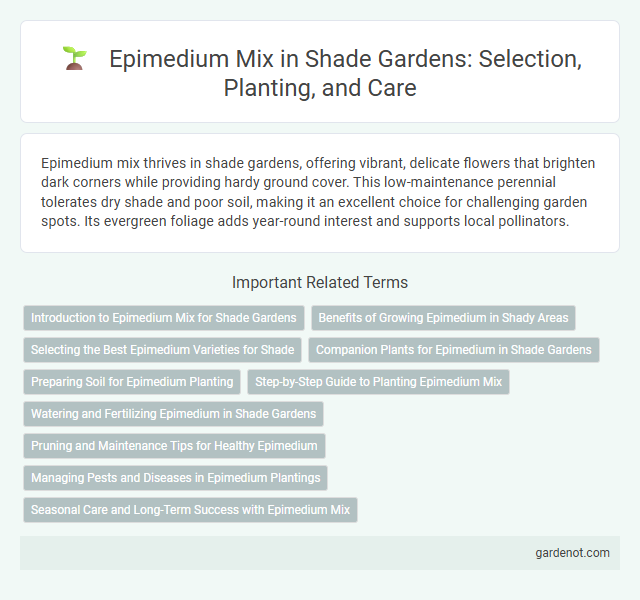Epimedium mix thrives in shade gardens, offering vibrant, delicate flowers that brighten dark corners while providing hardy ground cover. This low-maintenance perennial tolerates dry shade and poor soil, making it an excellent choice for challenging garden spots. Its evergreen foliage adds year-round interest and supports local pollinators.
Introduction to Epimedium Mix for Shade Gardens
Epimedium mix offers a diverse selection of hardy perennials ideal for shade gardens, thriving under tree canopies and low-light conditions. Known for their delicate, heart-shaped leaves and vibrant spring flowers, these plants provide excellent ground cover and seasonal interest with minimal maintenance. Their tolerance for dry shade and deer resistance makes Epimedium mixes a favored choice for landscaping shaded areas.
Benefits of Growing Epimedium in Shady Areas
Epimedium mix thrives in shady garden areas, providing excellent ground cover with its dense, evergreen foliage that suppresses weeds and conserves soil moisture. This perennial is highly tolerant of low light, making it ideal for under trees or other shaded spots where many plants struggle to grow. Its delicate, colorful flowers not only add visual interest but also attract pollinators, enhancing biodiversity in shaded garden environments.
Selecting the Best Epimedium Varieties for Shade
Epimedium varieties such as 'Amber Queen,' 'Purple Dragon,' and 'Frohnleiten' thrive in shaded garden areas due to their tolerance for low light and moist, well-drained soil. Selecting disease-resistant and evergreen types enhances ground cover aesthetics while suppressing weeds. Optimal Epimedium mixes balance foliage color, bloom time, and growth habit to create a dynamic, low-maintenance shade garden.
Companion Plants for Epimedium in Shade Gardens
Epimedium thrives in shade gardens when paired with companion plants such as hostas, ferns, and astilbes that share similar moisture and light needs. These shade-tolerant species enhance the garden's texture and seasonal interest while ensuring complementary growth patterns. Combining Epimedium with spring bulbs like snowdrops and wood anemones also creates layered blooms and extended visual appeal in shaded environments.
Preparing Soil for Epimedium Planting
Preparing soil for Epimedium planting involves creating a well-drained, humus-rich environment that retains moisture without becoming waterlogged. Incorporate organic matter such as compost or leaf mold to enhance soil fertility and structure, ensuring optimal root development. Maintaining a slightly acidic to neutral pH range between 6.0 and 7.0 supports nutrient availability for healthy Epimedium growth.
Step-by-Step Guide to Planting Epimedium Mix
Prepare well-drained, humus-rich soil in a shaded garden area to ensure optimal growth for Epimedium mix. Plant rhizomes 12 inches apart at a depth of 1 to 2 inches, covering with soil and watering thoroughly after planting. Maintain consistent moisture and mulch to protect roots, fostering vigorous emergence in early spring.
Watering and Fertilizing Epimedium in Shade Gardens
Epimedium thrives in shade gardens with consistent moisture but well-drained soil to prevent root rot. Water the plants deeply once a week, increasing frequency during dry spells to maintain steady hydration. Fertilize in early spring using a balanced, slow-release fertilizer to promote healthy growth and abundant foliage.
Pruning and Maintenance Tips for Healthy Epimedium
Pruning Epimedium mix is best done in late winter or early spring to remove old, damaged foliage and encourage fresh growth. Regularly removing faded flowers and dead leaves reduces disease risk and maintains a tidy appearance. Consistent moisture and well-drained, humus-rich soil support healthy development in shaded garden environments.
Managing Pests and Diseases in Epimedium Plantings
Epimedium mix thrives in shaded garden areas but requires vigilant pest and disease management to maintain healthy growth. Common pests such as aphids and slugs can damage leaves, while fungal diseases like powdery mildew may affect plant vigor, especially in humid conditions. Regular inspection, proper air circulation, and organic treatments like neem oil ensure the longevity and aesthetic appeal of Epimedium plantings.
Seasonal Care and Long-Term Success with Epimedium Mix
Epimedium mix thrives in well-drained, humus-rich soil with consistent moisture during the growing season. Regular mulching in spring helps retain soil moisture and suppress weeds, while pruning damaged foliage in late winter promotes healthy new growth. Over time, dividing mature clumps every 3 to 4 years encourages vigorous growth and prevents overcrowding, ensuring long-term success in shade garden environments.
Epimedium mix Infographic

 gardenot.com
gardenot.com